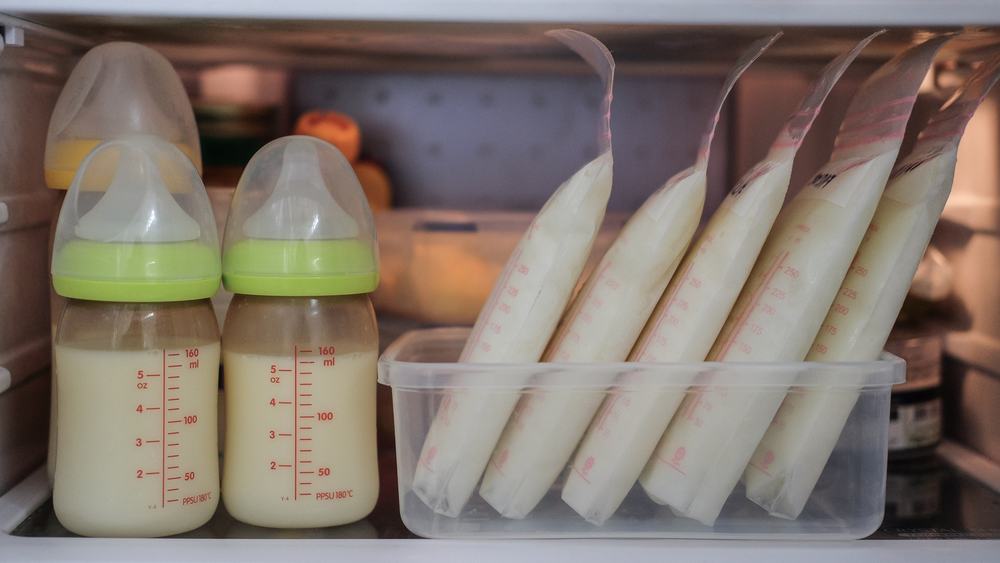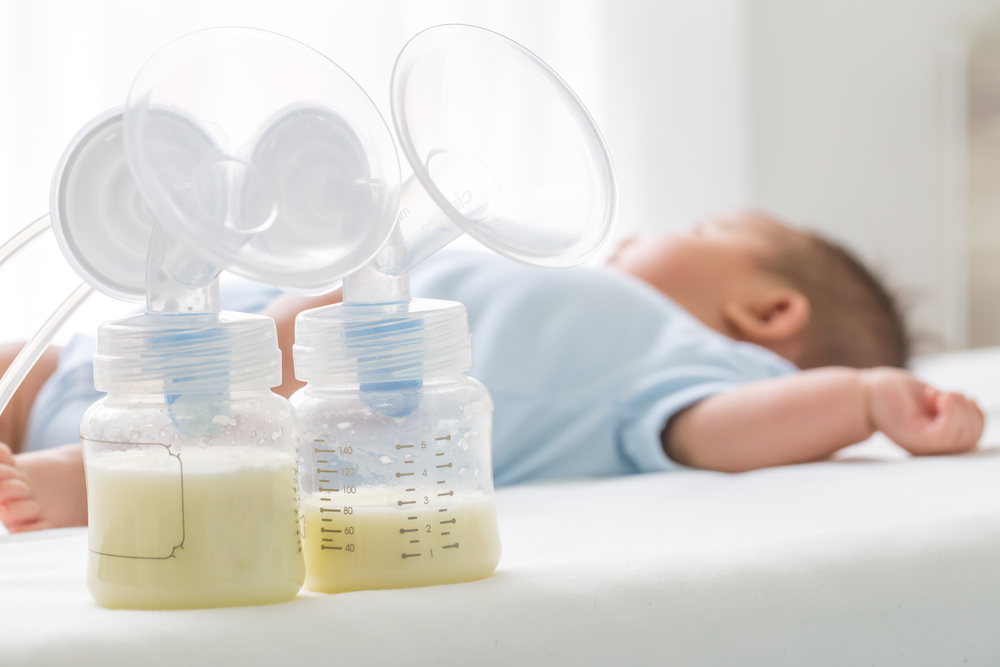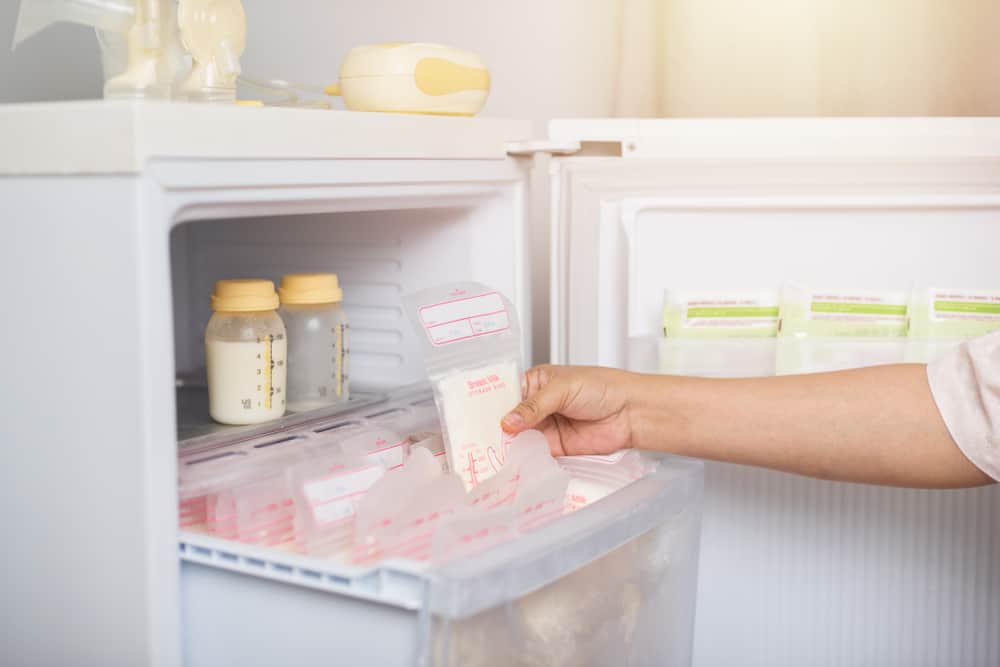“Don’t cry over spilled milk,” they say. But, they don’t know that you have a baby to feed, a breastmilk stash to build, and a career to come back to without disrupting your baby’s nursing habits. Before they start giving you unsolicited advice, we’re here to teach you how to build a milk stash while exclusively breastfeeding.
Now, going from nursing your newborn every moment of the waking hour to trying to figure out how on Earth you’re supposed to produce enough breastmilk when you go back to work can be disturbingly daunting.
Nonetheless, scrolling through an onslaught of Instagram posts showing mom’s freezers bursting with frozen breastmilk makes you wonder “Am I even a good mom?!”
Right off the bat, you are a great mom because you’re spending your nights Google searching for different ways to build a breastmilk stash rather than watching Netflix and resting your feet.
Worry not, we know a thing or two about breastfeeding and building a breastmilk stash (and we know everything about deep freezers!).
What are the benefits of building a breastmilk stash?

Whenever you’re scrolling through Instagram and thinking how perfect everyone’s life seems to be, remember that Instagram finds a way to make everything appear bigger, better, and brighter.
We understand that you’re probably wondering how to build a milk stash while exclusively breastfeeding because of Instagram moms urging you to do that, but what are the benefits of building a milk stash?
What are the reasons for you to start freaking out over a milk stash, and are they reasons enough?
On one hand, building a breastmilk stash ensures that you have enough breastmilk for your baby once you go back to work. Working moms need a generous supply of milk because they typically don’t have the wiggle room to pump between meetings and rely on the milk they produce that day.
We would also argue that working moms often don’t produce enough breastmilk due to stress, a poor pumping environment, and poor time management.
However, when working moms have a breastmilk stash on hand, they can defrost a few ounces whenever they need to without worrying whether they’re going to have enough milk for the day.
On the other hand, building a breastmilk stash benefits stay-at-home moms, too. Firstly, stay-at-home moms can experience days when they aren’t producing enough breastmilk, and a breastmilk stash can protect them from added stress.
Secondly, pumping and stashing can also provide stay-at-home moms with a stronger breastmilk supply (the more you pump, the more you provide) and confidence to keep up with the breastfeeding schedule.
How to build a milk stash while exclusively breastfeeding?
1. Start pumping after the first 3 to 4 weeks

When you’re trying to figure out how to build a milk stash while exclusively breastfeeding, you need to keep an eye on a few tips and tricks. We suggest, for example, that you start pumping after the first three to four weeks. Here’s why.
During the first few weeks, chances are you’re producing more breastmilk than you need because your supply’s trying to regulate.
While that might sound great, you might end up causing oversupply (which happens to be an even worse problem), and that’s why you should wait three to four weeks before you start pumping and stashing.
We also suggest creating a pumping schedule depending on when you’re coming back to work, how much breastmilk you need to stash, and for how long (breastmilk lasts for six to twelve months in the freezer).
2. Stick to a pumping schedule
When you get comfortable with feeding your baby and figure out your baby’s feeding schedule, add a pumping schedule to the routine.
By adding one or two pumping sessions each day, you might start feeling more comfortable with pumping and more confident with going back to work.
By starting early, you might have enough flexibility to bypass pumping on days when you don’t want to pump (without sacrificing the breastmilk stash).
We suggest pumping right after you breastfeed your baby (morning feedings are the most productive). Repeat the same when you breastfeed your baby at night, but make sure to not change the breastfeeding schedule during the day or the night.
Pump when your baby’s sleeping, or nurse with one breast and pump with the other simultaneously. Do whatever doesn’t overwhelm or overstimulate you.
3. Pump longer, pump stronger, pump more

Now, the “pump longer, pump stronger, pump more” mantra doesn’t need explanations. Never mind the fact that the more you pump the more breastmilk you produce, but the stronger and longer you pump the more you stimulate and strengthen your breasts.
If you normally pump for ten minutes per session, for example, try pumping for fifteen or twenty minutes. Even when you don’t see the breastmilk coming out right away, you might notice a difference after a few tries.
When you’re really trying to figure out how to build a milk stash while exclusively breastfeeding, try power pumping – pump for ten minutes, massage both breasts for a few minutes, then pump for ten minutes once more. Oh and, the more you repeat the process, the more progress you make.
4. Freeze, store, and use the breastmilk the right way
Nothing we talked about matters when you don’t know how to store the breastmilk the right way. No matter what you’ve heard or seen on Instagram, there are tips and tricks on how to store breastmilk to ensure nothing goes south.
Before pumping, for example, wash your hands, prepare the storage bags, and put dates on the storage bags. Store smaller batches of breastmilk (two to four ounces) or as much as your baby typically needs during feeding time. Usually, breastmilk should be used within two hours of feeding time.
Additionally, breastmilk expands while going through the freezing process which means you should make sure you don’t overfill the storage bags.
Breastmilk also shouldn’t be microwaved which means you should thaw the breastmilk slowly, by placing the storage bag in the refrigerator overnight and in a warm water bath before use.
5. Go easy on yourself

Figuring out how to build a milk stash while exclusively breastfeeding shouldn’t cause stress. A stressed-out mom doesn’t produce enough breastmilk, we already know that.
How do you, then, make sure you keep everything going without becoming anxious, overwhelmed, or overstimulated? Go easy on yourself.
Make time to pamper yourself and take care of your physical, emotional, and mental health. Surround yourself with people who are there for you and ready to fulfill your needs.
Whether that’s your partner, your family, or your friends, surround yourself with people who are willing to take care of the baby while you take care of yourself.
Remember, even on the off chance that you do need to resort to formula because you’re running out of breastmilk, you’re not a bad mom. Being a mom can never be about “all or nothing.”
How to store your breastmilk stash?
1. Freeze the milk within 24 hours of pumping
When you’re wondering how to build a milk stash while exclusively breastfeeding, you need to understand how important freezing, storing and using your milk stash actually is.
Whether or not you’re already familiar with these tips and tricks, we’ve gathered the ones you need the most (to ensure you don’t get overwhelmed by the sheer amount of information coming your way).
First off, you need to freeze the milk within 24 hours of pumping. When you do that, you preserve the nutrients that are responsible for keeping your baby happy and healthy, but you also make sure that the breast milk doesn’t go bad beforehand.
2. Freeze the milk in different portions

Buying proper storage bags saves you a lot of work. Smaller storage bags (two to four ounces) are more appropriate for breastmilk because it goes bad around two hours after you’re done defrosting, thawing, and warming a portion for your baby.
Also, different portions of breastmilk can also make your worries go away because you can store portions your baby typically eats during the feeding time and you can store smaller portions for when your baby gets hungry out of the blue or goes through a growth spur.
3. Leave a little room within the storage bags
When you’re freezing your breastmilk, remember to leave a little room within the storage bags because the breastmilk expands during the freezing process.
When you’re trying to keep your storage bags from bursting, try filling them only to about three-quarters full and squeezing out the air before sealing them.
4. Never store the milk within the freezer door compartments
When you store the breastmilk within the freezer door compartments, the breastmilk might thaw slowly every time you open the freezer to take something out. To prevent that from happening, store the bags at the back of the freezer where you typically get the coldest and the most consistent temperature.
5. Date each storage bag and use the oldest milk first
Finally, don’t forget to put the date on each storage bag. Whether you use breastmilk storage bags, bottles, or containers, don’t shy away from writing the pumping date on them to ensure you keep track of when the breastmilk might go bad.
Also, don’t forget to use the oldest milk first – a trick to make things easier seems to be to keep the oldest containers towards the front of the freezer, ready to go.
